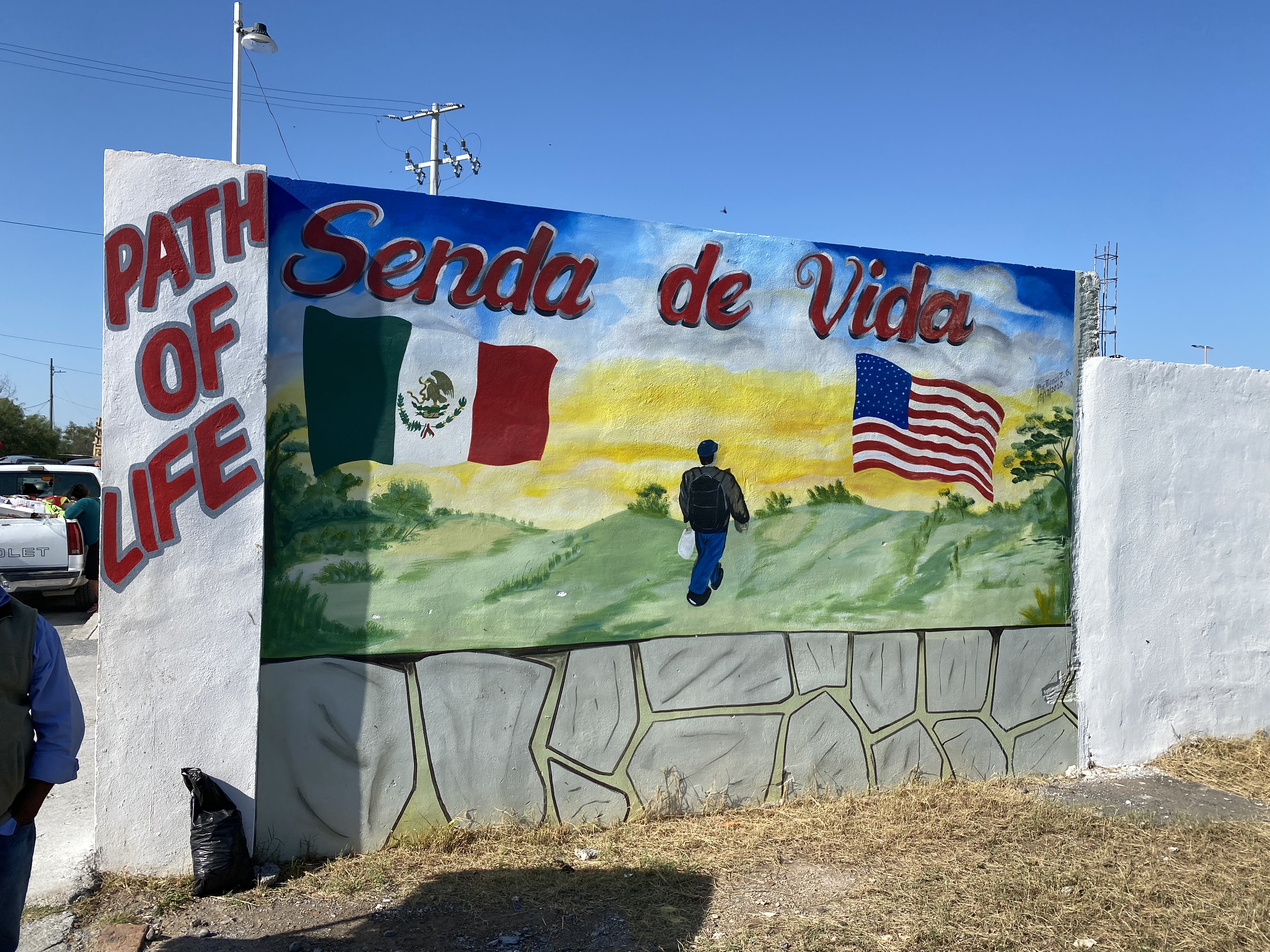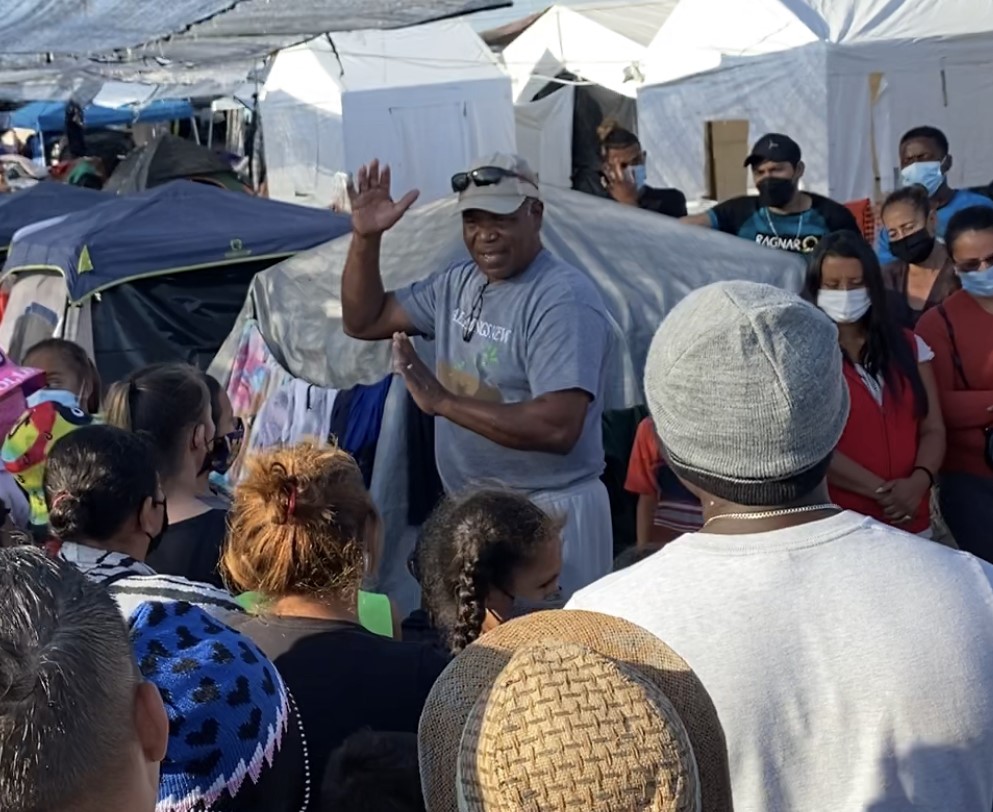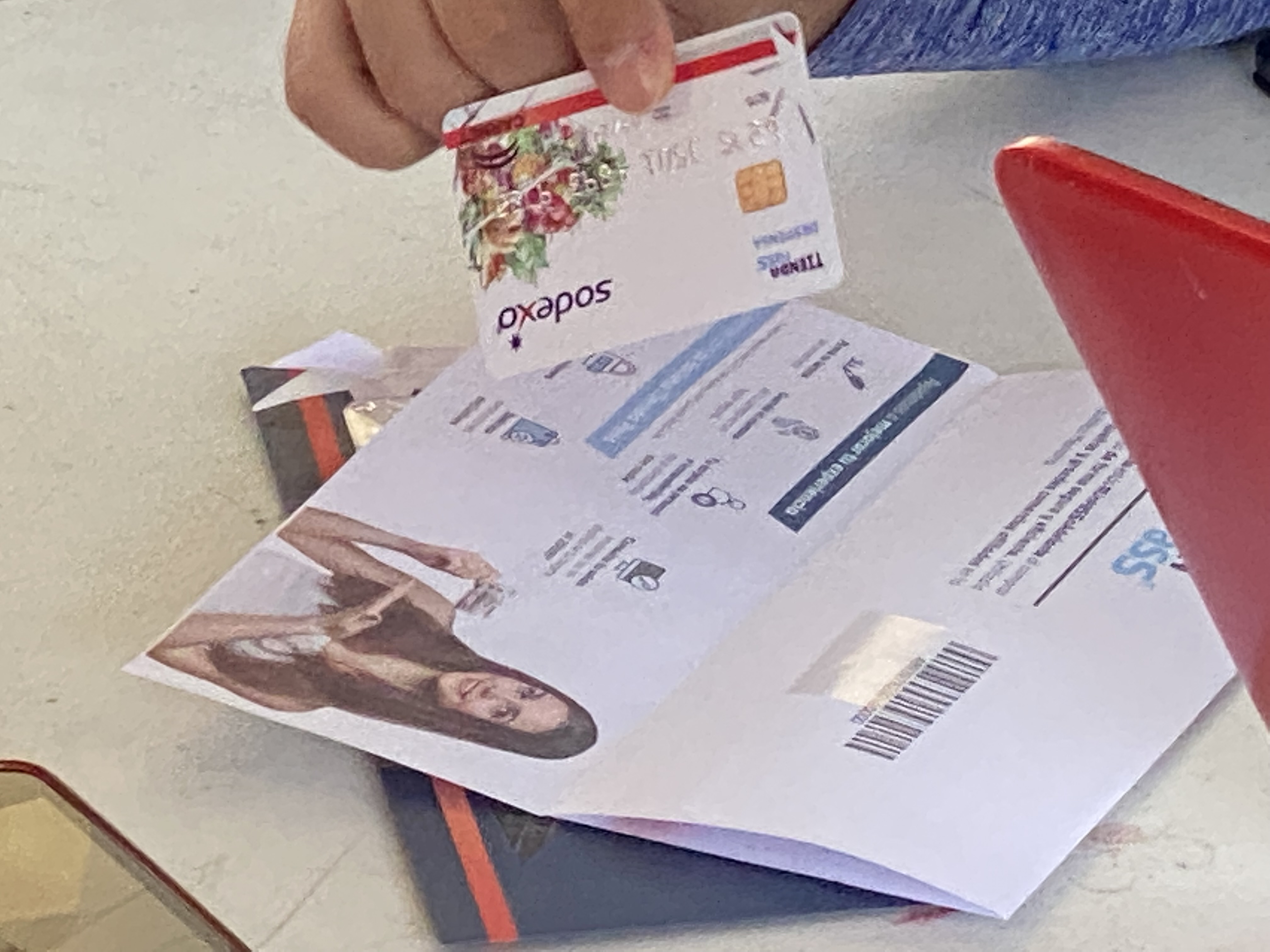
REYNOSA, Mexico – On a remote stretch of Rio Grande flood plain at the foot of this city of 600,000 within eyesight of McAllen, Texas, more than 1,200 migrants live in tents behind the tall cement walls of a 10-acre riverbank compound belonging to a Mexican non-profit organization that calls itself “Senda De Vida,” or Path of Life. Another 1,500 migrants aspiring to get inside fill a tent shanty town overflowing downtown Reynosa’s central plaza, with more coming every day, hoping to get in.
The migrants are flocking here by the thousands, enticed by a cheaper, surer, more comfortable “queue-management” arrangement that is quietly getting many into the United States – legally through a port of entry. Most are single adults and family groups that Border Patrol already caught illegally entering and expelled under the American pandemic protection “Title 42” policy to protect against the spread of Covid-19, or who don’t want to pay this city’s cartel smugglers to try a first time.
It has many official friends, including all levels of Mexican government, the United Nations, American immigration lawyers, non-profit migrant advocacy groups, and President Joe Biden’s Department of Homeland Security.
Boiled down, Senda De Vida helps expelled or newly arrived migrants begin the process of seeking asylum in the United States from Reynosa (often with a new cell phone app and assisted by American immigration lawyers) and then to wait in line for a rich reward: a CPB invitation to enter the United States at the port of entry on the way to settling in an American city of their choosing and to work while waiting for their asylum claims to adjudicate.
The Biden administration has allowed hundreds of thousands to receive the same reward already after many of those migrants paid steep smuggling fees to criminal Mexican syndicates and crossed illegally, with many still ending up expelled under Title 42 after paying.

But the Reynosa system offers a chance to bypass that investment risk and expense for those willing to wait – sometimes for several months – in conditions made comfortable enough to create a strong enticement for more migrants to try it out.
Mexican government agencies, unspecified private donors, and immigration advocates support all migrant needs for as long as it takes for the following to happen: Each morning in the shelter, the Biden administration’s U.S. Customs and Border Protection (CBP) across the river alerts shelter administrators that it will legally parole into the United States between five and 15 camp inhabitants (roughly 150 and 500 per month). These migrants apparently are given “notices to report” to the immigration office nearest to wherever they choose to settle in the United States, with legal authorization to be present and to work afforded to those pursuing asylum claims, whether to not they ever win them. To migrants, this is very good news, since the backlog for immigration court hearings has reached nearly four years.
Pastor Hector De Luna, who runs Senda De Vida, said cheers break out every morning when he gets on a bullhorn and calls out the day’s lucky winning (cell phone) number from a first-come, first-served list his organization keeps and matches to how many CBP said it they will take in.
“You need to see the person when they heard their number called. My God…,” he told the Center for Immigration Studies last week during an on-site visit to the compound and the downtown overflow camp. “By the next morning, the next day, they’re calling me… ‘I’m over here in Chicago! I’m going to Chicago. I’m flying to Chicago. I’m on the bus to Chicago.’ And always telling everybody because this can happen to anybody, wow, ‘I’m okay. Keep strong!’”
As more migrants downstream hear that message, they will no doubt head for Reynosa and, when they do, also report in turn that life in the Reynosa camps more than tolerable. For example:
- The UN’s International Organization for Migration (IOM) hands out debit cards to U.S.-bound migrant families here every two weeks ($800 a month for a family of four, IOM officials told CIS, but even more for larger families or less for single adults). IOM officials handing out the debit cards said they have been providing the money for many months.
- In scenes that stood in contrast with Mexico’s promise to the American government that it would deter and staunch illegal immigration through its territory, Mexico’s federal government – National Guard and men and women of that nation’s “vaccination brigade” – were in the camps last week providing Covid-19 vaccines to hundreds of the migrants. The purpose of the vaccinations was to prepare them for U.S. border crossings under new rules that require foreign nationals to provide evidence that they are vaccinated. CIS observed the Mexican federal government vaccinate hundreds of the Reynosa migrants who waited in long, winding lines.
- A private group provides daily classroom instruction for migrant children.
- Pastor De Luna did not provide specifics when asked who funds his operation supporting thousands of migrants and their basic needs for months at a time but said donations came from “people like you. We live by donations… churches, people in the United States…” In addition to the UN distributing debit cards, CIS observed well-stocked kitchens as well as piles of donated clothing and Mexican municipal, state, and federal agencies and several non-profits in the compound. The American immigration lawyers who work on the asylum claims were volunteers from different organizations, De Luna said.
Making second chances possible on the cheap
UN debit cards, clothing and three square meals a day, legal coaching about American asylum, and phone calls back home regaling successful bridge crossings undoubtedly attract more migrants to this city. These outcomes also provide an explanation for the expansion of migrant camps that has gone unexplored in the reporting to date. In addition to the roughly 3,000 who were in Senda De Vida’s queue last week in both the plaza and the compound several miles away, Pastor De Luna said 4,000 others were in queue while working and living in town waiting for the call.

CBP cooperates with the enterprise daily, communicating how many invitation slots the agency will grant and making sure its officers are there halfway down the international bridge for migrant handoffs under the watch of at least one of several American immigration lawyers, Pastor De Luna said.
“I decided to work with them [CBP] on one condition: We’re going to work together. You call on me, you tell me how many you want, and let’s walk up there,” he said.
For migrants, this system amounts to a cheaper, albeit longer-term, sure-fire gambit to secure the same prized outcomes the Biden administration has already granted to hundreds of thousands of mostly family group and unaccompanied minor migrants who entered illegally. Here’s why:
While the administration has rewarded hundreds of thousands of illegal crossers with quick interior resettlement for their smuggling investments, its Border Patrol still expelled a majority back to Mexico under the Title 42 health rule, including family groups.
The system developed in Reynosa essentially provides a second, surer chance for the expelled, but also for any other migrant who would prefer a comfortable, well-supported wait, rather than an expensive cartel smuggling fee that might go to waste due to a Title 42 expulsion.
Take Maria, a single, five-months-pregnant Honduran mother of an 8-year-old daughter, who spoke while in the compound. Two weeks earlier, she paid a Reynosa cartel smuggler $1,000 to cross her and her daughter over the Rio Grande so she could earn money to send home to parents. But Border Patrol caught them and returned the pair to Reynosa under Title 42.
She couldn’t afford another smuggling fee and thought of returning to Honduras or making a go of things in Mexico – until she heard about a second chance through Senda De Vida. An American lawyer helped her file papers with the U.S. government and now she’s in queue watching other migrants get invited in to America every day, filling her with new hope and informing her plan to stay until she get in. As an economic migrant, neither she nor most Central American migrants will likely qualify for asylum, which requires evidence of government persecution. But no matter to her, Maria said; her baby likely will be born a U.S. citizen. She’ll join other relatives in Virginia, and opportunities to make money await.
“I don’t have to return to Honduras; I won’t return to Honduras,” she said. “I want to be able to get a job and support my new baby.”
Other migrants in queue offered different reasons for joining the migrant camps of Reynosa. Haitian Jules Angelo, 26, who came to Reynosa with his 22-year-old sister during the September Del Rio migrant camp crisis, said they would not dare attempt an illegal crossing to America these days because recently the Biden administration deported several thousand Haitians from that Del Rio camp by air all the way back to Haiti.
“There were a lot of bad things happening with the American government,” he explained for his decision not to risk a crossing. “I would feel very bad to go back to Haiti. I know that if they catch me they could send me back.”
But he heard “from people, family members and friends” about an organization in Reynosa “that helps people cross into the United States.” Sure enough, the day after Angelo and his sister arrived, an American lawyer showed up and helped him download an app on his phone and file an application.
Now, things are really looking up, he said, as he sees other migrants get invited into the United States legally: “I feel more secure here than in any other place.”
The program has induced many others to stay for one of the most common reasons cited. Honduran Joel Alejandro Cortez Martinez said American authorities caught him and his daughter in Houston following a recent illegal border crossing and deported them to Mexico. He’d paid a $12,000 smuggling fee, a fortune raised by borrowing from family and friends.
Border Patrol sent them to Reynosa, where he ended up in the central plaza, broke and thinking of going home. But they’re in queue now for a legal crossing they see other migrants make every day, thanks to an American lawyer who helped him file an asylum application. To Cortez Martinez and others in his situation, this was a most fortuitous development, since he had no more money to pay smugglers for another crossing.
“I would not try to go to the river again because they ask for a lot of money,” the Honduran said, adding that there were consequences for trying without paying. “What I’ve heard is they [the cartel in Reynosa] make you disappear.”
What’s in it for the Americans
The Biden administration has not been quick to advertise its involvement in the Reynosa system, which harkens strongly to former President Trump’s use of queue management.
One of the new administration’s first moves, for instance, was to reverse President Trump’s Remain in Mexico policy, under which migrants were required to wait south of the border until their scheduled asylum hearing. That ensured that the migrants would not have been living inside the United States for months or years when they inevitably lost, enabling them to evade deportation orders by disappearing into the nation’s vast illegal population.
The Reynosa system actually most closely resembles a Trump-era predecessor of Remain in Mexico, a queue management policy used in 2018 and 2019 known as “metering”. In that policy, DHS required that migrants pool in Mexican camps to be let in a few at a time to apply for asylum and also to wait inside the country for adjudication.
The Biden administration in early November formally reversed the metering policy with a memo that, at the same time, seemed to allow for exactly the kind of metering going on in Reynosa.
The memorandum by Acting CBP Commissioner Troy Miller directed that his agency “may manage the intake of undocumented noncitizens at POEs [Ports of Entry], including by providing staffing at the border line to facilitate and manage safe and orderly travel into the POE. In all cases…undocumented citizens who are encountered at the border line should be permitted to wait in line, if they choose, and proceed into the POE for processing as operational capacity permits.”
And for this to happen, the acting commissioner noted, noncitizens should be encouraged to use a mobile application to submit their biographic and biometric information ahead of time and “thus streamline their processing upon arrival.” CBP also should “collaborate with interested non-governmental organizations and other key partners.”
But in at least one way, the Biden administration benefits from this sort of policy, especially were it to ever be expanded.
The administration’s handling of the border consistently polls poorly, and there are indications that this Reynosa system eliminates at least one potential firehose point of a mass migration that has swamped Border Patrol all along the Texas-Mexico epicenter of the crisis, often in front of news cameras.
With mid-term national elections on the horizon in 2022, anything that might staunch another massive hole in the dam can only help the optics in terms of sheer numbers. But even so, what is happening in Reynosa is uncannily reminiscent of Trump-era restrictionist policies.
If the Biden administration seems conflicted or confused, its nominal partner in Reynosa certainly is not. The pastor’s business card ambiguously bills the riverfront enterprise as a “center of support and assistance for migrants and deportees,” while its more telling logo leaves no room for interpretation: a backpack-carrying migrant walks the “Path to Life” from a Mexican flag toward an American one.
Editor's note: This article has been modified from its original publication to reflect that migrants in the Reynosa camp — with the assistance of American lawyers — were not formally applying for U.S. asylum there but, rather, filling out preliminary forms with CBP, via a new cell phone app, that can be used for an early part of the asylum process. All immigrants interviewed for this article said they believed they were applying for U.S. asylum.
